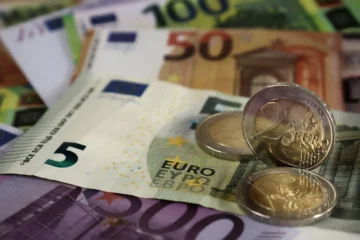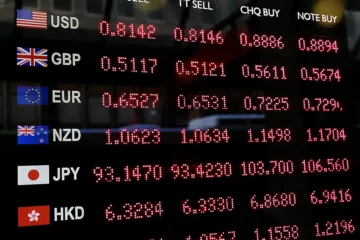US
U.S. markets were slightly higher last week as Q3 earnings season spurred some optimism, but global growth concerns limited it.
The S&P 500 was up 0.4% w-o-w, closing at 2,986 points, while the DJIA fell 1%, ending at 26,770. The Nasdaq Composite decreased 67 points (0.8%) to 8,089.
On Tuesday, JP Morgan Chase & Co, Goldman Sachs, Citigroup and Bank of America reported Q3 earnings. JP Morgan had the best third quarter in three years in its corporate and investment bank division. Both net income and revenue rose by 8%, to $9.1bn and $30.1bn respectively, surpassing analysts’ estimates. Fixed-income trading fees unexpectedly lifted by 25%. Bank of America’s net income increased by 4% to $7.5bn (excluding an impairment charge). Revenue was almost equal from the previous year, totalling $23bn. Goldman Sachs revenues missed expectations, with a net income down 26% to $1.88bn, and revenue dropping 6% to $8.32bn. Nevertheless, trading fees outpaced analysts’ consensus. Morgan Stanley saw its bottom-line soaring, with profit up 2.3% to $2.17bn and revenue at $10.1bn. The banks defined its quarterly revenue as the best in the past decade, also benefitting by a 21% jump in trading charges, $1.43bn. Citigroup saw a boost in its FICC division ($3.21bn), with overall profit for $4.9bn (+6%) and revenue at $18.6bn (+2%).
The FED started its T-bill purchases on Tuesday, to restore liquidity in the money market.
The yield on the 2-year Treasury closed down to 1.58% (it was 1.63% the week before), while the 10-year yield was a 1.75% (from 1.77%). The curve steepened as the market’s expectation for the FED to cut rates strengthened after the Index of Leading Economic Indicators for September lost 0.1% m-o-m.
On Tuesday, the International Monetary Fund (IMF) lowered for the fifth time its 2019 global growth forecast, slashing it from 3.2% to 3.0% and citing the drag from rising trade tensions. At the same time, retail sales in the U.S. saw an unexpected 0.3% decline in September
U.S. tariffs on $7.5 bn of E.U. goods took effect on Friday.
Next week releases will regard the House Price Index MoM, Durable Goods Order MoM, New Home Sales and the University of Michigan Consumer Sentiment.
Europe
Last week, European markets were mixed: the STOXX Europe 600 Index was flat (+0.06%) at 391.84, while the DAX went up by 1.4% to 12,633.60, and the FTSE 100 fell around 1.3% to 7,150.57. The 10-year bund yield was at -0.38%, while the 30-year persisted in a positive zone at 0.12%
The European Union passed the new Brexit deal, but the U.K. Parliament did not ratify it on Saturday. The German Government revised growth forecast for 2020 to 1% from 1.5%. Gloomy reports came from Renault and Danone, and their share prices dropped 11.5% and 8.4% respectively on Friday.
Next week investors eyes will be pointed to the Brexit delay and the ECB Interest Rate Decision on Thursday.
UK
This week, the endorsing of the new agreement by the EU grew hopes for a “deal Brexit” in the market pushing the pound to its highest level in 5 months. Specifically, the newfound optimism leads to the continuation of its appreciation against the Euro (+0.3007%) and the dollar (+0.9304%), with the GBPEUR at 1.165 and the GBPUSD at 1.298 on Friday.
However, as of Saturday, 19, the failure of the government to pass the agreement is expected to bring a new wave of uncertainty, next week, in the UK markets as the probability of a new referendum or new elections increases. Boris Johnson must now, once again, ask the European Union for an extension of the Brexit deadline.
The FTSE 100 closed on Friday at 7.150,57, down 1.19% from last week’s levels as the Brexit clock ticks down. It is clear that uncertainty in the trading bloc has trapped UK stocks into a “Brexit Spiral” as indicated by the FTSE index performance in the past months. Clarity on the issue is essential for a change in market sentiment and return to normality.
Asia
Chinese stocks recorded another loss on the weekly time-chart after missing its growth forecasts for the third quarter. The only industry standing out against all odds this September was industrial production. More specifically, data shows an increase of 5.8% year-on-year, after a modest 4.4% rise in August whilst beating the market expectation of 5%.
The Chinese Ministry of Commerce spokesman, Gao Feng, said on Thursday that for a final agreement to be reached, the U.S. has to remove tariffs. The weak China growth data in combination with the everlasting uncertainty regarding the US-China trade deal was translated in the Hong Kong markets by poor performance. The Hang Seng Index (HSI) and the Hang Seng China Enterprises Index (HSCE) falling by -0.5%. The Shanghai Composite Index (CSI) also plummeted by -1.4%.
The trade wars have been having a major slowdown effect on the Chinese economy. However, it should be mentioned that the yearly growth target of 6-6.5% is still attainable unless further escalation of trade wars emerges. The use of further easing to achieve these targets by China is almost certainly probably out of the picture since China has already relied on credit for growth for more than ten years now.
This week, in Japan, the Nikkei Index gained 1.82% the Topix index surged 1.42%, marking their biggest weekly gain in four weeks. These results were driven amid positive expectations of a resolving of the US-China trade disputes.
Japan, being the fourth-largest global exporter explains why Japanese markets are so much affected by the developments of the Trade Wars. Japanese investors kept buying overseas equities (48.5 billion yen worth, this past week) for the third consecutive week, which is also a clear indication of this fact, as it illustrates optimistic sentiment regarding the outcome US and China negotiations.
The Japanese yen made a new weekly high in the past 3 months reaching a high of (108.94), however closing at (108.35) on Friday. This closure is indicative of limited gains for the days ahead and is likely caused by worries over a US-China trade deal. It should be mentioned, however, that USD/JPY can see a major upside surge in the case that the first phase of the partial trade is signed this November or beginning of December.



0 Comments